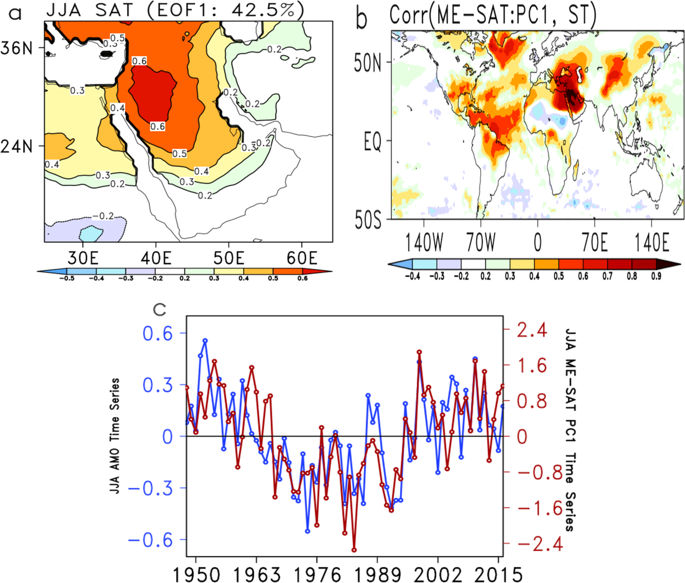npj Climate and Atmospheric Science ( IF 8.5 ) Pub Date : 2020-01-30 , DOI: 10.1038/s41612-020-0109-1 Muhammad Azhar Ehsan , Dario Nicolì , Fred Kucharski , Mansour Almazroui , Michael K. Tippett , Alessio Bellucci , Paolo Ruggieri , In-Sik Kang

|
Middle East surface air temperature (ME-SAT), during boreal summer (June to August: JJA), shows robust multidecadal variations for the period 1948−2016. Here, using observational and reanalysis datasets, as well as coupled atmosphere–ocean model simulations, we linked the observed summer ME-SAT variability to the multidecadal variability of sea surface temperature (SST) in the North Atlantic Ocean (AMV). This Atlantic−ME connection during summer involves ocean–atmosphere interactions through multiple ocean basins, with an influence from the Indian Ocean and the Arabian Sea. The downstream response to Atlantic SST is a weakening of the subtropical westerly jet stream that impacts summer ME-SAT variability through a wave-like pattern in the upper tropospheric levels. The Atlantic SST response is further characterized by positive geopotential height anomalies in the upper levels over the Eurasian region and a dipole-like pressure distribution over the ME in lower levels. For positive Atlantic SST anomalies this pressure gradient initiates anomalous low-level southerly flow, which transports moisture from the neighboring water bodies toward the extremely hot and dry ME landmass. The increase in atmospheric moisture reduces the longwave radiation damping of the SAT anomaly, increasing further ME-SAT. A suite of Atlantic Pacemaker experiments skillfully reproduces the North Atlantic–ME teleconnection. Our findings reveal that in observations and models the Atlantic Ocean acts as a critical pacemaker for summer ME-SAT multidecadal variability and that a positive AMV can lead to enhanced summer warming over the Middle East.
中文翻译:

大西洋对中东夏季地表气温的影响
北方夏季(6月至8月:JJA)的中东地面气温(ME-SAT)在1948-2016年期间表现出强劲的年代际变化。在这里,我们使用观测和再分析数据集,以及耦合的大气-海洋模型模拟,将观测到的夏季ME-SAT变异性与北大西洋(AMV)海面温度(SST)的多年代际变化联系起来。夏季,这种大西洋—ME的连接涉及到印度洋和阿拉伯海的影响,通过多个海盆的海气相互作用。对大西洋SST的下游响应是副热带西风急流的减弱,它通过对流层高层的波型影响夏季ME-SAT的变化。Atlantic SST响应的特征还在于,欧亚地区上层正地势高度异常高,而下层ME上偶极子状压力分布。对于积极的大西洋海表温度异常,该压力梯度会引发异常的低水平南风,从而将水分从邻近水体输送到极热和干燥的ME陆地。大气湿度的增加减少了SAT异常的长波辐射衰减,从而进一步增加了ME-SAT。一组大西洋起搏器实验巧妙地再现了北大西洋-ME的远程连接。











































 京公网安备 11010802027423号
京公网安备 11010802027423号